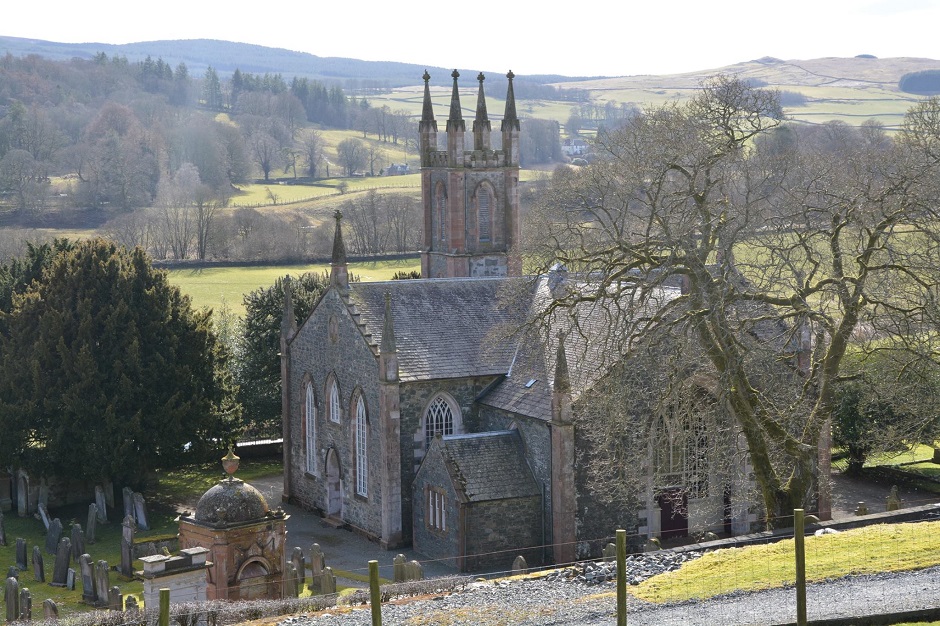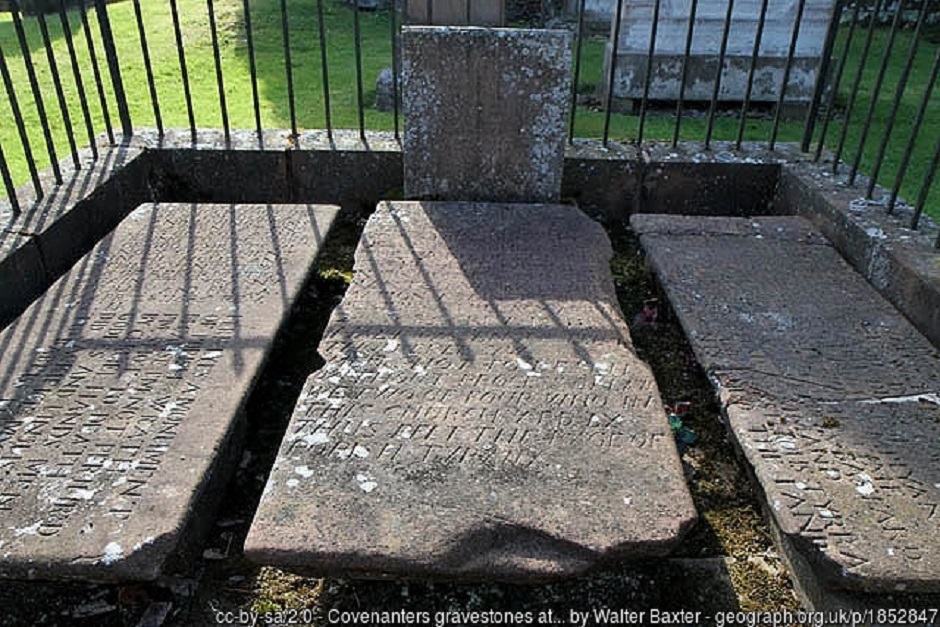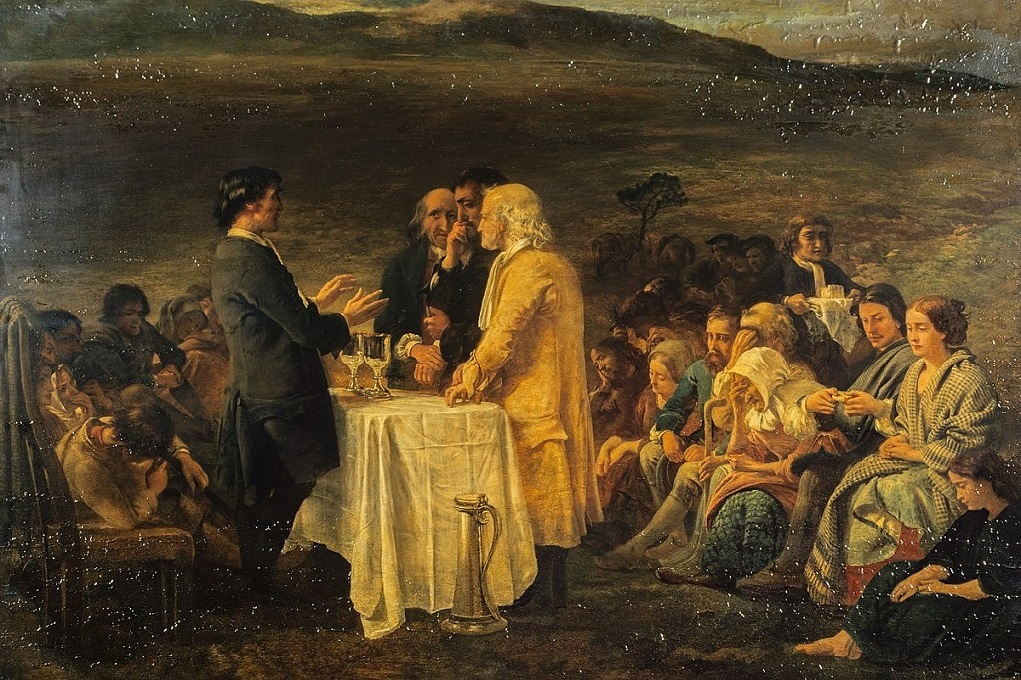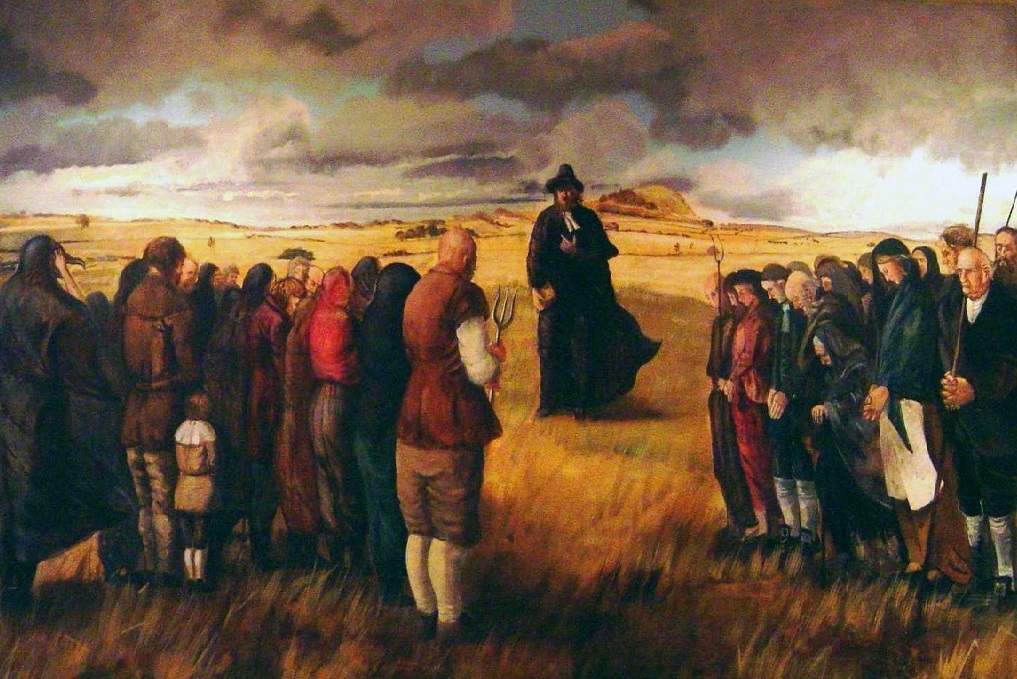Wee History of the Scottish Covenanters
BEGINNINGS:
The Good News of Jesus was first brought to Scotland by St Ninian, who founded a Church in Whithorn around 397 AD, in the Fourth Century. The Church was known as Candida Casa, meaning ‘Shining Light’ – possibly a reference to the Light of the Gospel, with Jesus being proclaimed as the Light of the World. Like most of the first Christian missionaries to Scotland, we may assume that Ninian, inspired by ‘mission impetus,’ visited the area north and west of Whithorn, and so could have reached the Cairn Valley, though there are no detailed accounts of his missionary journeyings.
1125:
The next half-millennium is shrouded by few records or artifacts of any sort. However, there are occasional exceptions. For example, the Ruthwell Cross, restored in a kirk near Annan – possibly dating from the Eighth Century – provides a powerful visual aid to the death and glorious Resurrection Life of Jesus. On its edges is carved in runes the powerful poem, “The Dream of the Rood” (ie The Dream of the Cross). A very moving and tenderly executed carving on one face of the cross depicts Mary of Magdala washing Jesus’ feet
A key date in the formation of Scotland as a nation may have come in the Tenth Century, in 937AD, when the Battle of Brunanburh was perhaps (as Neil Oliver argues in his book, “A History of Scotland”), crucial to the formation of the nation we now call Scotland.
However, in the history of Glencairn itself, the next clearly authenticated date is 1125. This date appears on a built-up doorway in the ruins of the pre-1840s Kirk. The doorway is in the “Norman style,” which suggests that the main architectural style for church buildings throughout Western Europe in those centuries had penetrated as far north as Southern Scotland. Presumably, the church architecture was but one element in a broad acceptance of Christian ethical, cultural and social understandings.
A COVENANTED NATION:
In contrast to the previous half-millennium, suddenly in the 17th. Centuries, records and artifacts proliferate – largely as a result of the activities of the Covenanters.
There are only two people-groups in history who have joined together specifically to covenant their nation to God: one was Ancient Israel, the other was Modern Scotland. The Covenant was primarily a commitment of spiritual principle, which arose out of contentious political issues. In the reign of the English king, Charles 1 (1625 – 1649), an attempt was made to bring the Scottish Church in line with the tradition which had developed in England. His father, James 1 had acted slowly and wisely: Charles was neither cautious nor wise! He attempted to impose an episcopal organization on the Scottish Church, and to introduce a new Prayer Book for use in Scotland. Such ‘innovations’ ignited Scottish opposition. In 1638, the Presbyterian leadership in Scotland drew up a document which was described as a ‘National Covenant,’ which was personally signed, extraordinarily, by huge numbers of ordinary Scots, as well as their ecclesiastical and political leaders. This was an amazing achievement, at a time when problems of illiteracy, communication, and transport might have prevented widespread national involvement with any such document. The Covenant bound the signatories to resist all ecclesiastical innovations which might in any way be understood to demean the unique position of Jesus as sole King over His Church. In practice, this meant opposing the episcopal system which gave King Charles a privileged position in the Church as ‘Supreme Governor.’ Fiercely Scottish and Presbyterian, the Covenanters were suspicious of all things English and Anglican. A recent History of Scotland records one understanding of this movement: “For the first time in history the ordinary men and women – the mass of us – were briefly visible.”
The Covenanters remained a substantial force in Scotland throughout the 1640s; and in 1651, at his Scottish coronation, Charles 11 reluctantly promised that he himself would sign and swear to the Covenant. However, after his Restoration in 1660, the new king was not true to his word, and quickly moved against the Covenanters. Around three hundred Presbyterian ministers were turned out of their parishes. South-West Scotland was a center of covenanting resistance, and in the secluded hills of the area, outdoor preaching and worship was widely practiced in meetings which became known as “Conventicles.” These open-air meetings were declared illegal – with the insistence that worship should only be conducted in ‘authorized’ church buildings; yet they were attended by ‘Covenanting Scots,’ who gathered together in their hundreds and even thousands. (One meeting place close to Glencairn was “Crickup Lynn” – an ideal secluded site in the moorland hillsides.) In opposition to this popular movement, governmental authorities fiercely tried to stamp out the opposition of the Covenanters: covenant documents were burned, and covenanting ministers were ordered to resign or be banished. These non-conformists were fined, tortured, or even executed without trial. In and around Glencairn, as a heartland of covenanting resistance, mercenary armies, led by ambitious Scots who were subservient to the English monarch, traversed the region.
These ‘killing times’ intensified under the rule of King James II (I685 – 1688). Many Covenanter leaders were arrested, exiled, or killed. An estimated 18,000 people died in 25 years. Of those who lived, many were sold as slaves to America, or were entombed in dungeons. Often these martyrs were young men; some were teenagers. Other individual Covenanters – especially some covenanting ministers – fled to Holland. Many a graveyard tombstone in the South-West of Scotland fiercely records the deaths of Covenanters during the ‘killing times.’ In the Kirkland Cemetery, there are four such tombstones. Typically, one reads:
“Here lyes James Bennoch, shot by Col. Duglas
And Livingdton’s Dragoons at Engleston
For adhering to the Word of God,
Christ’s kingly government in His Church,
And the covenanted work of Reformation
Against tyranny, perjury and prelacy.
April 28 1685.
Rev 12. 11.”
This Scripture reference reads: “They triumphed over him [Satan] by the blood of the Lamb and by the word of their testimony; they did not love their lives so much as to shrink from death.”

THE LAST MARTYR ON BRITISH SOIL
James Renwick was born in Moniaive. At the age of twenty, during these “killing times” he was secretly sent to Holland to study for the ministry. He returned to the Glencairn and Nith Valleys, where he exercised a powerful and influential ministry – though politically unlawful – in the neighboring moors and glens. He was eventually captured and hanged at Edinburgh in February 1688 at the age of 26, becoming the last Christian martyr on British soil.
On the scaffold, James Rennie insisted that he was dying for Christ, “the Prince of the kings of the earth, who alone must bear the glory of ruling in his own kingdom the church.” “Then he sang Psalm 103, read Rev. 19; then prayed, commending his soul to God through the Redeemer . . . . He told the assembled crowd, “Spectators, I am com here this day to lay down my life for adhering to the truths of Christ, for which I am neither afraid nor ashamed to suffer . . . . I own the word of God as the rule of faith and manners.”
A few months later, King James abdicated the British throne, fleeing abroad from London in what became popularly known as the ‘Glorious Revolution.’ In Scotland, one consequence was a speedy church settlement, in which Presbyterianism was finally and firmly established as the accepted form of church government in Protestant Scotland. The ‘killing times’ had come to an end.
FOLLOWING JESUS “TO THE ENDS OF THE EARTH.
The early Nineteenth Century saw Scots folk gaining a global perspective. And those who were serious followers of Jesus realized that their appropriate response was to embrace the whole world as a Christian mission initiative. David Livingstone and Mary Slessor became well known as Sots who traveled to equatorial Africa. Of course, not all of these travelers were Christian missionaries. For example, one obelisk-shaped gravestone near the entrance to the Kirkland Kirk building marks the grave of a local man who became Surgeon-General in Sierra Leone. He was William Aitkin of Laggan, Glencairn, and he served as Colonial Surgeon for 24 years in the first half of the Nineteenth Century, dying in 1862. It must have taken some courage to travel from Glencairn to Freetown and its hinterland in those days, when the area was known as “the white mans’ grave.” (This description may be attributed partly to the scourge of malaria in the Sierra Leone area, and the failure of incoming white-men to understand that the often-fatal illness was caused, medically, through malarial-bearing mosquitos.)
But relations between Glencairn and the wider world were not limited to Equatorial Africa during the Nineteenth and Twentieth Centuries. A more recent tombstone in the Kirkland Cemetery records the life of Don Fleming, who was born in Shantung in China, of missionary parents. He followed their example, and devoted himself to Christian mission in China for his working life. Thereafter he came to live in Moniaive. As if to note and celebrate the worldwide links which were typical of the fabric of social life in Glencairn in the 20th. Century, the same tombstone records that Don’s wife Mildred was born in Sydney, Australia!
FOLLOWING JESUS THROUGH WORLD WARS
As Glencairn became increasingly connected with the wider world, many Scots emigrated to what were then “far distant” countries. For example, Walter McCall from Kirkland emigrated to New Zealand early in the Twentieth Century. With the outbreak of the First World War, he enlisted in the New Zealand memorials in the Moniaive Kirk indicate that far greater numbers of enlisted soldiers from Glencairn died in the First World War than in the Second.)
JANE HERNING
During the Second World War, the Dunscore Kirk bears witness to an amazing story of Christian faith and sacrifice. Jane Herning was a Glencairn-born school teacher who had volunteered during the !930s to care for a group of Jewish orphan children in Budapest. When the Nazis invaded Hungary, she refused to leave her charges, and Armed Services, and found himself with a New Zealand detachment in the Dardenelles. There he was killed in action. He is just one example of men born in Glencairn who enlisted as soldiers in the First World War, a sad memory which was replicated twenty years later in the Second World War (though the was eventually transported with them to the notorious Concentration Camp of Buchenwald, where she was eventually killed.
LIVING SIMPLY IN ORDER THAT OTHERS MAY SIMPLY LIVE
In the later 20th. For Centuries, the “rich nations” (mainly living in Western Europe and the American continent) gained a greater awareness of being “world citizens,” and a deepening sense of responsibility towards poor and starving people, especially in Africa and the Indian sub-continent. Committed disciples of Jesus began to realize that the oft-repeated cry of the Old Testament Psalmist on behalf of the “poor and needy” had acquired a global dimension. The invention of the radio (and later, television) brought worldwide poverty, and the lack of the basics of life for the majority of people in the world, inescapably into the homes of Glencairn residents
Dunscore became recognized as an “eco Church” in the early 21st. Century, which not only heightened a sense in committed followers of Jesus that they were following the One through whom “all things came into being” (John !: 3) and “the world was made through Him” (10). Perhaps this emphasis on the responsibility of all humans to care for the well-being of creation also served to enhance the sense of responsibility to care for the less privileged majority of the world’s human inhabitants.

REVIVAL
During the 20th Century, Moniaive and Dunscore grew in population, whilst numbers living in the surrounding countryside of Glencairn declined. For example, it has been estimated that at the beginning of the Century, around twenty people lived in the four small cottages situated on the road in front of the Kirkland Kirk. By the beginning of the 21st. For Centuries, just two people permanently lived there! Clearly, the Kirk building had become redundant – with adequate Church accommodation being provided in the two little villages just mentioned. The Kirkland building was proving a huge and unnecessary drain on local Kirk finances, and so was sold to American buyers, who modified it to be a “second home” in Glencairn. They kept the bulk of the 1840s Kirk furniture in place, with the possibility of further uses for the building. This was significant for Glencairn, since the Glencairn Kirk building has the largest seating capacity of any building in the Glen.
However, it would be untruthful to ignore the impact in Glencairn of increasing secularization in Scottish social and cultural life throughout the 20th Century – and on into the 21st. Some have argued that the devastating impact of two World Wars vastly contributed to the decline of traditional religious observance. But, whatever the reasons, the impact in Glencairn cannot be ignored. Surely only a real revival of true faith in the Person of Jesus Christ is adequate to the spiritual needs of the early 21st Century. It is an encouragement that there are records of a number of such “revivals” in recent Scottish history – and in the lives of other Celtic nations more generally (such as Wales) within the UK.

The noun “revival” is not used in Scripture, but its verbal form is to be found in Psalm 85: 6: “Will You not revive us again, that Your people may rejoice in You?” Revival is an experience among God’s people, and the whole of the New Testament may be encapsulated in this single word. Revival has been described as “God revealing Himself in awful holiness and irresistible power. It is such a manifest working of God that human personalities are overshadowed, and human programmes abandoned.” It is encouraging that Scotland has often known such events. Indeed, one recently published book, concentrating on Scottish history, is entitled, “Land of Many Revivals”!
Followers of Jesus in Glencairn, in company with His followers globally, are on a mission, for the words of Jesus Himself are urgent and uncompromising: “Go into all the world and preach the Gospel” (Mark 16: 15).
Article Credit: Rev. Dr. Malcolm McCall R.N.
Photo Credit – Wikimedia Commons
Photo Credit – Auloudon – WordPress.com
Photo Credit – Culture NL Museums
Photo Credit – wikidata.org
Photo Credit – en.wikipedia.org
Photo Credit –Walter Baxter – geograph.org.uk





